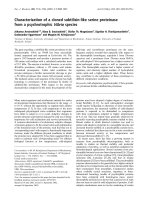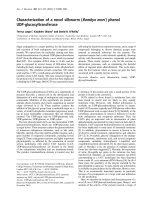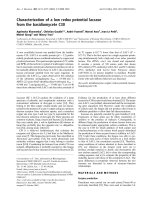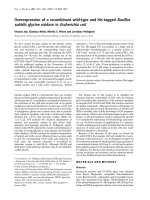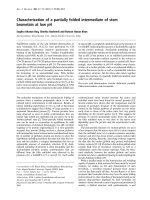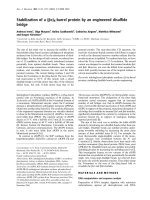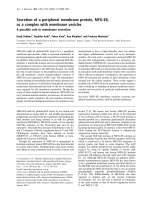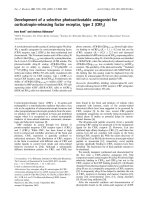Báo cáo y học: "valuation of a recombinant human gelatin as a substitute for a hydrolyzed porcine gelatin in a refrigerator-stable Oka/Merck live varicella vaccine." pps
Bạn đang xem bản rút gọn của tài liệu. Xem và tải ngay bản đầy đủ của tài liệu tại đây (234.2 KB, 6 trang )
BioMed Central
Page 1 of 6
(page number not for citation purposes)
Journal of Immune Based Therapies
and Vaccines
Open Access
Original research
Evaluation of a recombinant human gelatin as a substitute for a
hydrolyzed porcine gelatin in a refrigerator-stable Oka/Merck live
varicella vaccine
Vladimir Liska*
1
, Stacey A Bigert
2
, Philip S Bennett
3
, David Olsen
4
,
Robert Chang
4
and Carl J Burke
2
Address:
1
Vaccine Clinical Research, Merck Research Laboratories, P.O. Box 1000, UG3CD28, North Wales, PA 19454, USA,
2
Biologics and
Vaccines, Merck Research Laboratories, West Point, PA 19486, USA,
3
NonClinical Statistics, Merck Research Laboratories, West Point, PA 19486,
USA and
4
FibroGen, Inc., South San Francisco, CA 94080, USA
Email: Vladimir Liska* - ; Stacey A Bigert - ; Philip S Bennett - ;
David Olsen - ; Robert Chang - ; Carl J Burke -
* Corresponding author
Abstract
Background: The labile nature of live, attenuated varicella-zoster virus (Oka/Merck) requires
robust stabilization during virus bulk preparation and vaccine manufacturing in order to preserve
potency through storage and administration. One stabilizing ingredient used in a varicella-zoster
virus (VZV) vaccine is hydrolyzed porcine gelatin which represents the major protein/peptide-
based excipient in the vaccine formulation.
Methods: In this comparative study, a recombinant human gelatin fragment (8.5 kD) was assessed
as a potential replacement for hydrolyzed porcine gelatin in an experimental live, attenuated VZV
(Oka/Merck) vaccine. VZV (Oka/Merck) was harvested in two formulations prepared with either
a hydrolyzed porcine gelatin or a recombinant human gelatin. Moreover, the viral stability in the
experimental VZV (Oka/Merck) vaccines was evaluated under accelerated and real-time conditions
in a comparative study.
Results and discussion: The stabilizing effect of recombinant human gelatin on VZV (Oka/Merck)
potency change during vaccine lyophilization was similar to the experimental vaccine containing
porcine-derived gelatin. Vaccine viral potency changes were comparable in stabilized VZV (Oka/
Merck) formulations containing either hydrolyzed porcine gelatin or recombinant human gelatin.
No statistically significant difference in potency stability was observed between the vaccine
formulations stored at any of the temperatures tested.
Conclusion: The recombinant human gelatin demonstrated similar ability to stabilize the live
attenuated VZV (Oka/Merck) in an experimental, refrigerator-stable varicella vaccine when
compared to the vaccine preparation formulated with hydrolyzed porcine gelatin used in currently
marketed varicella vaccine.
Published: 23 February 2007
Journal of Immune Based Therapies and Vaccines 2007, 5:4 doi:10.1186/1476-8518-5-4
Received: 15 December 2006
Accepted: 23 February 2007
This article is available from: />© 2007 Liska et al; licensee BioMed Central Ltd.
This is an Open Access article distributed under the terms of the Creative Commons Attribution License ( />),
which permits unrestricted use, distribution, and reproduction in any medium, provided the original work is properly cited.
Journal of Immune Based Therapies and Vaccines 2007, 5:4 />Page 2 of 6
(page number not for citation purposes)
Background
Varicella virus vaccine live is a lyophilized preparation of
live, attenuated VZV (Oka/Merck) [1]. The inherent labil-
ity of the live varicella virus (Oka/Merck) presents a for-
mulation challenge in terms of stabilizing and preserving
vaccine viability during manufacturing, storage and
administration [2]. The refrigerator-stable varicella vac-
cine formulation contains stabilizers such as sucrose,
hydrolyzed porcine gelatin, phosphate, glutamate, and
urea, as well as a live attenuated varicella virus (Oka/
Merck) and residual components of MRC-5 cells [1].
Hydrolyzed porcine gelatin is a major protein/peptide-
based component of the final formulation, as well as a
component used in the processing of VZV (Oka/Merck)
bulk intermediate [2]. The exact mechanism of gelatin-
mediated protection to the vaccine virus is unknown. It is
believed that gelatin provides non-covalent and non-spe-
cific protective binding to the virus particles that enhances
their stability. In addition, hydrolyzed gelatin creates and
maintains desirable structure/appearance of a lyophilized
vaccine cake [2]. The current manufacturing process of
hydrolyzed porcine gelatin yields preparations which con-
sist of a mixture of protein fragments of different sizes [3].
Hydrolysis converts high molecular weight gelatin
(>100,000 Da) to low molecular weight gelatin (between
2000 and 5000 Da) [4]. Low molecular weight gelatin is
less likely to stimulate gelatin-specific IgE than high
molecular weight gelatin in vaccinated subjects [5]. Cur-
rently, the incidence of anaphylactic reactions to the
hydrolyzed porcine gelatin is very low (approximately 1
case per 2 million doses) [4]. In contrast, use of non-
hydrolyzed gelatin in vaccine formulations by Japanese
vaccine makers in the past led to higher incidence of gela-
tin-specific immediate-type hypersensitivity reactions in
vaccinated subjects in Japan [6-10].
The implementation of alternative, well-defined substi-
tutes for biological materials of human or animal origin
in vaccine formulations is a desirable trend in pharmaceu-
tical industry. To support this goal, recombinant human
gelatin, termed FG-5001, was obtained using a yeast
expression system and a completely defined fermentation
and purification process (FibroGen, Inc., South San Fran-
cisco, CA). FG-5001 is a low molecular weight human
sequence-based gelatin fragment (8.5 kDa) that can be
used as a substitute for animal-derived material and has
been shown to function as an effective alternative stabiliz-
ing ingredient in a live attenuated influenza vaccine [11].
In this study, FG-5001 was evaluated as a potential
replacement for hydrolyzed porcine gelatin in an experi-
mental refrigerator-stable varicella vaccine formulation.
VZV (Oka/Merck) was harvested in two formulations pre-
pared with either a hydrolyzed porcine gelatin or FG-
5001. The stabilizing effect of FG-5001 on VZV (Oka/
Merck) during vaccine lyophilization was assessed. More-
over, the short-term, as well as long-term VZV (Oka/
Merck) potency stability under accelerated and real-time
storage conditions was evaluated in a comparative study.
VZV (Oka/Merck) potency change after a short-term sta-
bility study under accelerated conditions (37°C for 7
days) was similar for both vaccine preparations. Even
more importantly, vaccine virus potency losses associated
with a long-term storage under accelerated conditions at
15°C for 12 months and real-time conditions at -15°C
and at 2–8°C for 24 months were similar for both hydro-
lyzed porcine gelatin- and recombinant human gelatin-
stabilized vaccines. Thus, recombinant human gelatin,
FG-5001, demonstrated a similar ability to stabilize the
live attenuated VZV (Oka/Merck) in an experimental
refrigerator-stable varicella vaccine when compared to the
vaccine preparation formulated with a hydrolyzed por-
cine gelatin.
Methods
Preparation of experimental varicella (Oka/Merck) viral
bulks
Culture flasks with VZV (Oka/Merck)-infected MRC5 cells
were obtained from Merck Manufacturing Division
(MMD, West Point, PA). The VZV (Oka/Merck) contain-
ing MRC5 cells were harvested into two formulations pre-
pared with either a hydrolyzed porcine gelatin (SOL-U-
PRO; Dynagel Inc., IL), or 8.5 kD recombinant human
gelatin (FG-5001; Lot # 04AE001, FibroGen, Inc., CA),
and further harvested in a small-scale process closely
mimicking current manufacturing procedure for VZV
(Oka/Merck) bulk preparation. Both processed bulks were
aliquoted, placed in a liquid nitrogen batch freezer (Kwik-
Freeze Freezing System, AIRCO, NJ, USA), frozen and
transferred to -70°C. A set of small frozen liquid sample
aliquots (1.0 mL) was submitted for VZV plaque assay
analysis to determine VZV (Oka/Merck) potency changes
during bulk processing for both, SOL-U-PRO- and FG-
5001-containing, varicella bulks.
Preparation of experimental, refrigerator-stable varicella
vaccine samples
Varicella virus vaccine live (Oka/Merck) is a lyophilized
preparation. When this refrigerator-stable vaccine is
reconstituted as directed, each 0.5 mL dose contains the
following: a minimum of 1350 plaque forming units
(PFU) of Oka/Merck varicella virus, approximately 18 mg
of sucrose, 8.9 mg of hydrolyzed gelatin, 3.6 mg of urea,
2.3 mg of sodium chloride, 0.36 mg of monosodium L-
glutamate, 0.33 mg of sodium phosphate basic, 57 mcg of
potassium phosphate monobasic, 57 mcg of potassium
chloride. The product also contains residual components
of MRC-5 cells including DNA, protein and trace quanti-
ties of neomycin and bovine calf serum from MRC-5 cul-
ture media. The product contains no preservative [1].
Journal of Immune Based Therapies and Vaccines 2007, 5:4 />Page 3 of 6
(page number not for citation purposes)
Experimental, refrigerator-stable varicella vaccine samples
containing either the porcine hydrolyzed gelatin, or
recombinant human gelatin, were prepared in a small-
scale procedure closely mimicking current manufacturing
process for varicella vaccine. Briefly, aliquots (40 mL) of
SOL-U-PRO- and FG-5001-stabilized VZV (Oka/Merck)
bulks were quickly thawed in water bath (30°C), and then
diluted into their respective gelatin-containing formula-
tions to a target potency of ≈ 4.4 log
10
pfu/mL. Final for-
mulated bulk (FFB) aliquots (0.7 mL) of both
experimental vaccines were filled in glass vials, partially
stoppered, placed in a liquid nitrogen batch freezer and
frozen. These frozen FFB samples were divided into two
groups. The first group was transferred to a -70°C freezer
and was later used as a control to determine the VZV
(Oka/Merck) potency change after lyophilization. The
second group of samples was transported to the lyophili-
zation chamber (Usifroid Lyophilizer Model SMH 101,
Usifroid SA, France), and lyophilized. After lyophiliza-
tion, the vaccine vials were inspected, sealed and placed in
stability stations.
Short term and long-term vaccine stability study under
accelerated and real-time conditions
In addition to storage at -15°C and 2–8°C to examine
real-time conditions, the stability stations used for storage
were tempered at 15°C and 37°C to examine the vaccine
potency stability under accelerated conditions. At pre-
determined time points (37°C for 7 days; 15°C for 3, 6,
9, 12 months; 2–8°C and 15°C for 3, 6, 9, 12, 24 months)
vaccine vials were removed from stability stations and
stored at -70°C until submission for VZV (Oka/Merck)
potency analysis. Sample vaccine vials from individual
time points were analyzed together with their respective
control samples which had been stored at -70°C. In addi-
tion, three sample vials from each time point were also
submitted for moisture analysis from the long-term stabil-
ity study executed at 2–8°C for 24 months.
VZV (Oka/Merck) plaque assay analysis
VZV (Oka/Merck) potency in both viral bulk preparations
and experimental vaccine samples were determined by
VZV plaque assay with liquid overlay medium [12]. Ana-
lyzed samples (thawed liquid bulk samples and FFB liq-
uid vaccine samples, as well as reconstituted lyophilized
vaccine samples) were diluted with the stabilizer and sub-
mitted for analysis in 1 × 12 assay format (one sample in
each of 12 independent assay runs). VZV (Oka/Merck)
potency was defined as a log
10
of VZV plaque forming
units (PFU) per mL.
Moisture content analysis of lyophilized vaccine samples
The amount of moisture in the lyophilized vaccine sam-
ples was determined by the Karl Fischer coulometric titra-
tion method [13] using an Aquatest™ coulometric
moisture titration system (Photovolt Instruments, Inc.,
Minneapolis, MN) according to the manufacturer's
instructions. For each analysis, average moisture content
(%) was calculated based on valid results from three
tested vaccine samples.
Statistical analysis
The potency losses associated with lyophilization were
calculated as the average of the differences observed
between the liquid samples and the -70°C (lyophilized)
samples tested in the same 12 assay runs. The standard
error of the loss estimate was simply the standard devia-
tion of the observed differences divided by the square root
of the number of runs in which a difference was calcu-
lated. The same calculations were performed with the sta-
bility data for 37°C for one week. Within run differences
between the -70°C (lyophilized) samples and the 37°C
samples were determined and averaged across 12 inde-
pendent runs. The data generated for long term stability
estimation consisted of concurrent testing of "incubated"
samples (those stored at -15°C, 2–8°C, and 15°C for pre-
specified interval) along with control samples from the
same lot which were stored only at -70°C. For each stabil-
ity interval, 12 incubated vials and 12 control vials were
tested, one vial each, in 12 independent assay runs. The
potency loss at that interval was calculated as the average
difference between the control and incubated sample
within each run. This format helps to minimize the poten-
tial for run-to-run differences in the assay affecting the sta-
bility estimation. For each of the two formulations, linear
regression analysis was performed using the individual
loss estimates at each long term storage temperature.
Results
VZV (Oka/Merck) potency changes after lyophilization of
experimental varicella vaccines
VZV-infected MRC5 cells were harvested into two stabiliz-
ers containing either SOL-U-PRO or FG-5001, in a small-
scale process which closely mimicked the manufacturing
procedure for VZV (Oka/Merck) bulks. Both, SOL-U-PRO
and FG-5001-stabilized VZV (Oka/Merck) bulks were fur-
ther used in the preparation of experimental refrigerator-
stable varicella vaccines. These experimental varicella vac-
cine formulations were prepared in a small-scale formula-
tion, filling, freezing, and lyophilization procedure
closely mimicking the current manufacturing process for
varicella vaccine. The VZV (Oka/Merck) potency losses
associated with lyophilization were similar for both
experimental, hydrolyzed porcine gelatin-(0.79 log
10
PFU
with a standard error ± 0.03) and the recombinant human
gelatin-containing (0.70 log
10
PFU with a standard error ±
0.06) varicella vaccines. After lyophilization, the vials
with varicella vaccine samples were placed in the stability
stations for short-term, as well as long-term varicella vac-
cine potency stability studies.
Journal of Immune Based Therapies and Vaccines 2007, 5:4 />Page 4 of 6
(page number not for citation purposes)
Short-term thermal stability study of experimental
varicella vaccines under accelerated conditions
The main objective of this experiment was to assess the
effect of a recombinant human gelatin, FG-5001, on the
short-term stability of VZV (Oka/Merck) potency in exper-
imental, refrigerator-stable varicella vaccine formulation
under accelerated conditions (37°C for 7 days) in a com-
parative study with a vaccine formulated with SOL-U-
PRO. Similar potency changes were observed for both vac-
cine formulations, containing either porcine gelatin (0.47
± 0.03 log
10
PFU per 7 days) or recombinant human gela-
tin (0.44 ± 0.07 log
10
PFU per 7 days), after short-term
exposure to thermal stress at 37°C for 7 days. Thus, the
replacement of porcine gelatin with recombinant human
gelatin-based product does not appear to have a signifi-
cant effect (p = 0.49) on thermal stability of VZV (Oka/
Merck) as seen in this study. Moreover, lyophilized vari-
cella vaccine formulations made with both gelatin prepa-
rations demonstrated a high percentage of cakes with
excellent integrity that was maintained even after short-
term exposure to thermal stress (data not shown).
Long-term stability study under accelerated and real-time
conditions
Following lyophilization, vaccine samples were placed in
stability chambers tempered at 2–8°C and -15°C for
long-term (24 months) stability study under real-time
conditions. In order to assess VZV (Oka/Merck) potency
stability under accelerated conditions, a set of both types
of vaccine samples were also placed in a stability chamber
tempered at 15°C for 12 months. The virus potency losses
associated with long-term storage (log10 PFU loss per
month, linear regression model) at 2–8°C (Fig. 1A), -
15°C (Fig. 1B), and 15°C (Fig. 1C), were similar for the
two hydrolyzed porcine gelatin- and recombinant human
gelatin-containing varicella vaccines (p = 0.94, 0.87, and
0.97, respectively). The loss rate estimates for each type of
gelatin-stabilized vaccine, as well as a pooled estimate
combining the data from both vaccines are listed in Table
1. No statistically significant difference in potency stabil-
ity was observed between the vaccine formulations stored
at any of the temperatures tested. During the long-term
study (24 months) under real-time conditions (2–8°C),
the averaged moisture content values of hydrolyzed por-
cine gelatin-(2.33% ± 0.12 standard error) and recom-
binant human gelatin-containing (2.27% ± 0.07 std error)
vaccine samples were comparable (p = 0.68). No statisti-
cally significant trend in moisture content over time at 2–
8°C was found for either formulation (p > 0.05).
Discussion
Experiments summarized above analyzed the suitability
of recombinant human gelatin, FG-5001, as a replace-
ment for hydrolyzed porcine gelatin, SOL-U-PRO, in an
experimental, refrigerator-stable varicella vaccine prepara-
tion. In our study, vaccine preparations containing either
SOL-U-PRO or FG-5001 demonstrated comparable VZV
(Oka/Merck) short-term, as well as long-term potency sta-
bility under accelerated and real-time conditions. Statisti-
cal analysis of VZV (Oka/Merck) potency changes during
the long-term stability study under real-time conditions
showed no statistically significant difference in VZV
potency stability for either formulation stored at any of
the temperatures tested. In addition, FG-5001 performed
similarly to SOL-U-PRO when it was used as a component
in a process to generate bulk virus, as well as during prep-
aration of a liquid vaccine formulation, filling into vials,
freezing, and lyophilization.
In another short-term stability study under accelerated
conditions, Olsen et al. [11] demonstrated that FG-5001
functioned as an effective live virus stabilizer, maintaining
the titer of a live attenuated influenza strain A/Sydney
CAZ-002 as well as a gelatin hydrolysate (Kind & Knox
Corporation, Sioux City, IA). This study indicated the sin-
gle polypeptide contained the full biological activity of a
commercially available processed animal gelatin product.
Hydrolyzed animal-derived gelatins are widely used in the
pharmaceutical industry as stabilizers in vaccines and
other biopharmaceuticals. The heterogeneous nature of
these protein mixtures creates a challenge with respect to
their analytical characterization. The yeast-produced
recombinant human gelatin fragment, FG-5001, is a prod-
uct of defined molecular weight and physical-chemical
properties, and represents a new biomaterial not previ-
ously available from animal sources [3].
Table 1: The combined potency loss rate estimates of VZV (Oka/Merck) in both, hydrolyzed porcine gelatin (SOL-U-PRO), as well as
recombinant human gelatin (FG-5001) stabilized, experimental refrigerator-stable varicella vaccine formulations stored at -15°C and
2–8°C for 24 months, and at 15°C for 12 months, respectively. The potency loss rates are in log
10
PFU per month.
Potency Loss Rate Estimates (95%CI)
Storage Temperature SOL-U-PRO FG-5001 Combined
-15°C 0.000 (-0.004,0.005) 0.000 (0.005, 0.005) 0.000 (-0.003, 0.004)
2–8°C 0.005 (0.000, 0.010) 0.005 (0.000, 0.010) 0.005 (0.001, 0.009)
15°C 0.033 (0.017, 0.049) 0.033 (0.017, 0.048) 0.033 (0.022, 0.044)
Journal of Immune Based Therapies and Vaccines 2007, 5:4 />Page 5 of 6
(page number not for citation purposes)
The long-term stability of VZV (Oka/Merck) formulated in hydrolyzed porcine gelatin (SOL-U-PRO), or recombinant human gelatin (FG-5001) stabilized varicella vaccine matricesFigure 1
The long-term stability of VZV (Oka/Merck) formulated in hydrolyzed porcine gelatin (SOL-U-PRO), or recombinant human
gelatin (FG-5001) stabilized varicella vaccine matrices. The VZV (Oka/Merck) potency change was determined as a difference
between the potency of control samples stored at -70°C, and samples stored at 2–8°C (Figure 1A), and -15°C (Figure 1B) for
24 months, and 15°C (Figure 1C) for 12 months, respectively. The value of 0 for the potency loss (change) at time interval 0
months represents the stability model starting at that point. Vaccine samples were analyzed by the VZV plaque assay in format
1 × 12. The VZV potency change is in log
10
PFU/mL.
-0.3
-0.1
0.1
0 8 16 24
Months at 2-8
o
C
Potency Change (log
10
PFU / mL)
SOL-U-PRO
FG-5001
A
-0.2
0.0
0.2
0816
Months at -15
o
C
Potency Change (log
10
PFU / mL
24
)
SOL-U-PRO
FG-5001
B
-0.6
-0.3
0.0
048
Months at 15
o
C
Potency Change (log
10
PFU / mL
12
)
SOL-U-PRO
FG-5001
C
Publish with Bio Med Central and every
scientist can read your work free of charge
"BioMed Central will be the most significant development for
disseminating the results of biomedical research in our lifetime."
Sir Paul Nurse, Cancer Research UK
Your research papers will be:
available free of charge to the entire biomedical community
peer reviewed and published immediately upon acceptance
cited in PubMed and archived on PubMed Central
yours — you keep the copyright
Submit your manuscript here:
/>BioMedcentral
Journal of Immune Based Therapies and Vaccines 2007, 5:4 />Page 6 of 6
(page number not for citation purposes)
While gelatin producers and end-users have investigated a
number of natural and synthetic substitutes for the ani-
mal-source gelatin currently available, a universal substi-
tute has not yet been found. On the contrary,
recombinant yeast technology can provide suitable
human gelatin-based materials that can be highly purified
and fully characterized. These genetically distinct mole-
cules can potentially be used as an alternative substitute
for hydrolyzed animal-derived gelatins and other excipi-
ents currently used in a variety of pharmaceutical prod-
ucts. Even more importantly, this new technology allows
the production of recombinant human-based gelatins
with pre-defined molecular weight, isoelectric point (pI),
guaranteed lot-to-lot reproducibility, and the ability to
tailor the molecule to match a specific pharmaceutical
application.
Acknowledgements
The authors would like to recognize the technical contribution to this work
provided by Jeffrey Blue. The authors would also like to thank Christine
Lotz for preparation of this manuscript.
References
1. Package insert: Varivax
®
(Varicella Virus Vaccine Live (Oka/
Merck)), Refrigerator-stable formulation. Manuf and dist by
Merck & Co., Inc., Whitehouse Station, NJ, USA; 2005.
2. Burke CJ, Hsu T-A, Volkin DB: Formulation, stability, and deliv-
ery of live attenuated vaccines for human use. Crit Rev Ther
Drug Carrier Syst 1999, 16:1-83.
3. Olsen D, Yang C, Bodo M, Chang R, Leigh S, Baez J, Carmiachael D,
Perala M, Hamalainen E-R, Jarvinen M, Polarek J: Recombinant col-
lagen and gelatin for drug delivery. Adv Drug Delivery Rev 2003,
55:1547-1567.
4. Offit PA, Jew RK: Addressing parent's concerns: Do vaccines
contain harmful preservatives, adjuvants, additives, or resid-
uals? Pediatrics 2003, 112(6):1394-1397.
5. Sakay Y, Yamato R, Onuma M, Kikuta T, Watanabe M, Nakayma T:
Non-antigenic and low allergic gelatin produced by specific
digestion with an enzyme-coupled matrix. Biol Pharm Bull 1998,
21(4):330-334.
6. Sakaguchi M, Inouye S: Systemic allergic reactions to gelatin
included in vaccines as a stabilizer. Jpn J Infect Dis 2000,
53(200):189-195.
7. Kelso JM: The gelatin story. Allergy Clin Immunol 1999,
103:200-202.
8. Kumagai T, Yamanaka Y, Wataya Y, Umetsu A, Kawamura N, Ikeda
K, Furukawa H, Kimura K, Chiba S, Saito S, Sugawara N, Kurimoto F,
Dakaguchi M, Inouye S: Gelatin-specific humoral and cellular
immune responses in children with immediate- and nonim-
mediate-type reactions to live measles, mumps, rubella, and
varicella vaccines. J Allergy Clin Immunol 1997, 100:130-134.
9. Kelso JM, Jones RT, Yunginger JW: Anaphylaxis to measles,
mumps, and rubella vaccine mediated by IgE to gelatin. J
Allergy Clin Immunol 1993, 91:867-872.
10. Sakaguchi M, Ogura H, Inouye S: Measurement of IgE antibody to
gelatin in children with immediate-type reactions to measles
and mumps vaccines. J Allergy Clin Immunol 1995, 96:563-565.
11. Olsen D, Jiang J, Chang R, Duffy R, Sakagutchi M, Leigh S, Lungard R,
Ju J, Buschman F, Truong-Le V, Pham B, Polarek JW: Expression and
characterization of a low molecular weight recombinant
human gelatin: development of a substitute for animal-
derived gelatin with superior features.
Protein Expr Purif 2005,
40:346-357.
12. Krah DL, Schofield TL, Provost PJ: Enhancement of varicella-
zoster virus plaquing efficiency with an agarose overlay
medium. J Virol Methods 1990, 27:319-326.
13. Fischer K: Neues Verfahren zur massanalytischen Bestim-
mung des Wassergehaltes von Flüssigkeiten und festen
Körpern. Angew Chem 1935, 48:394-396.
